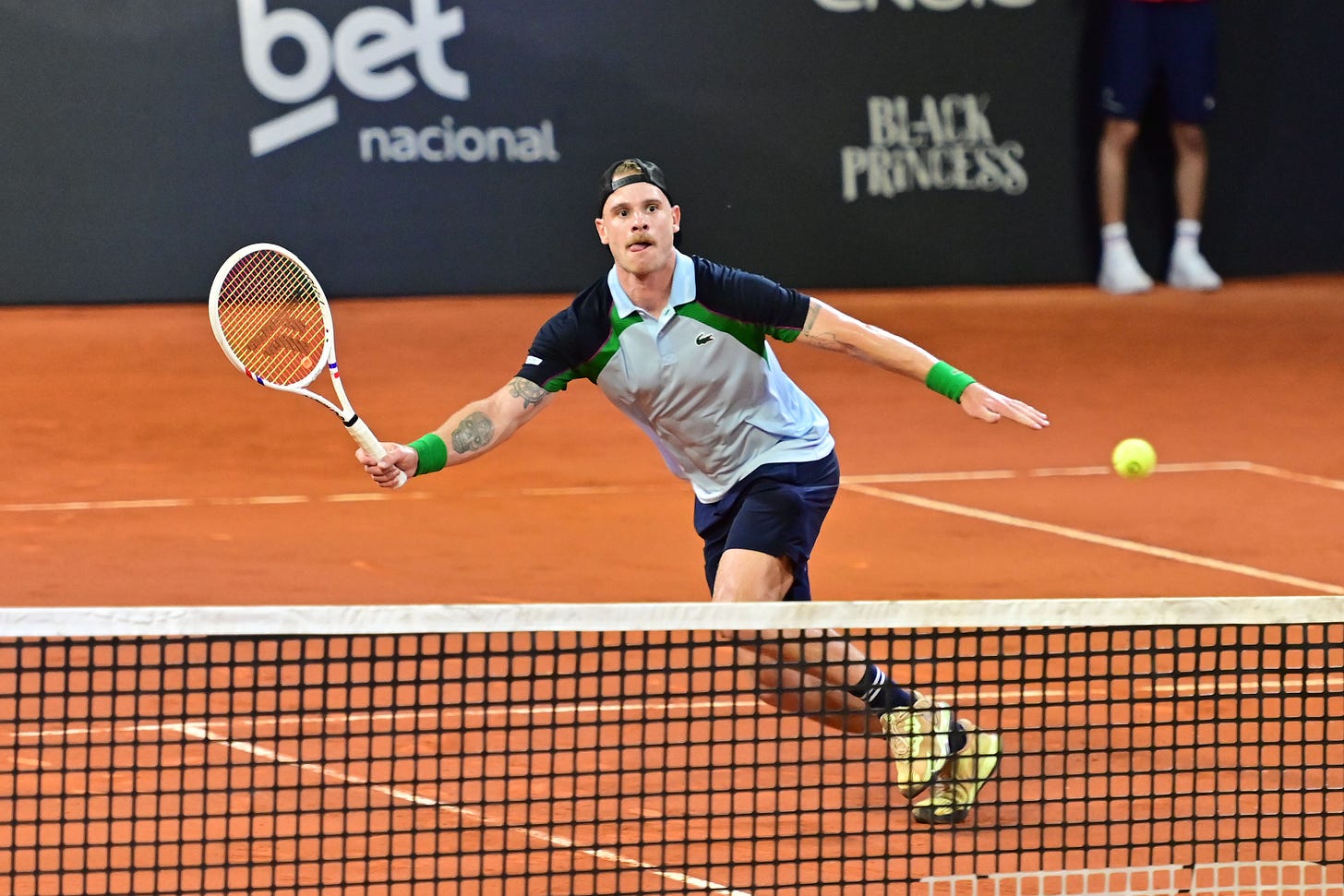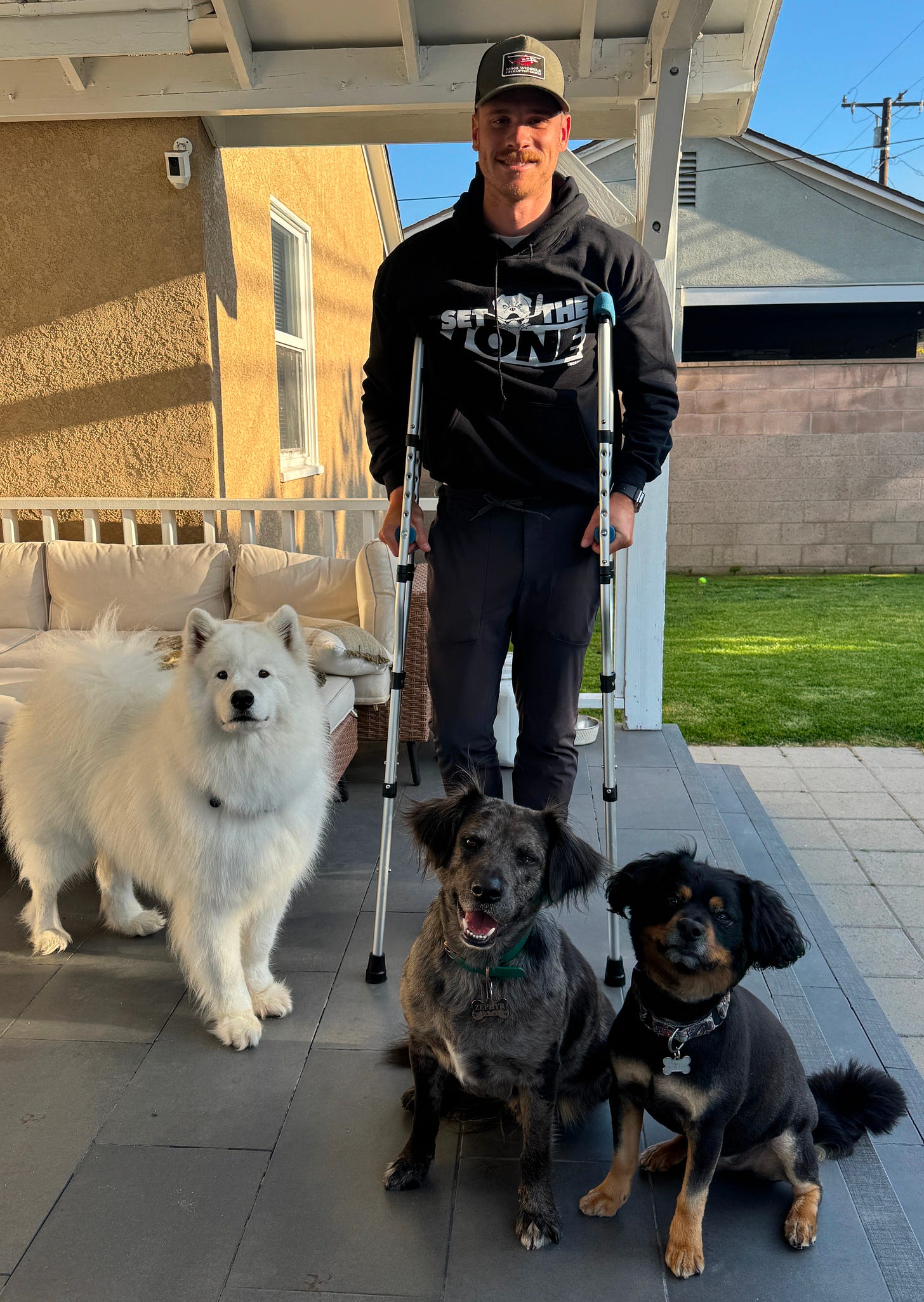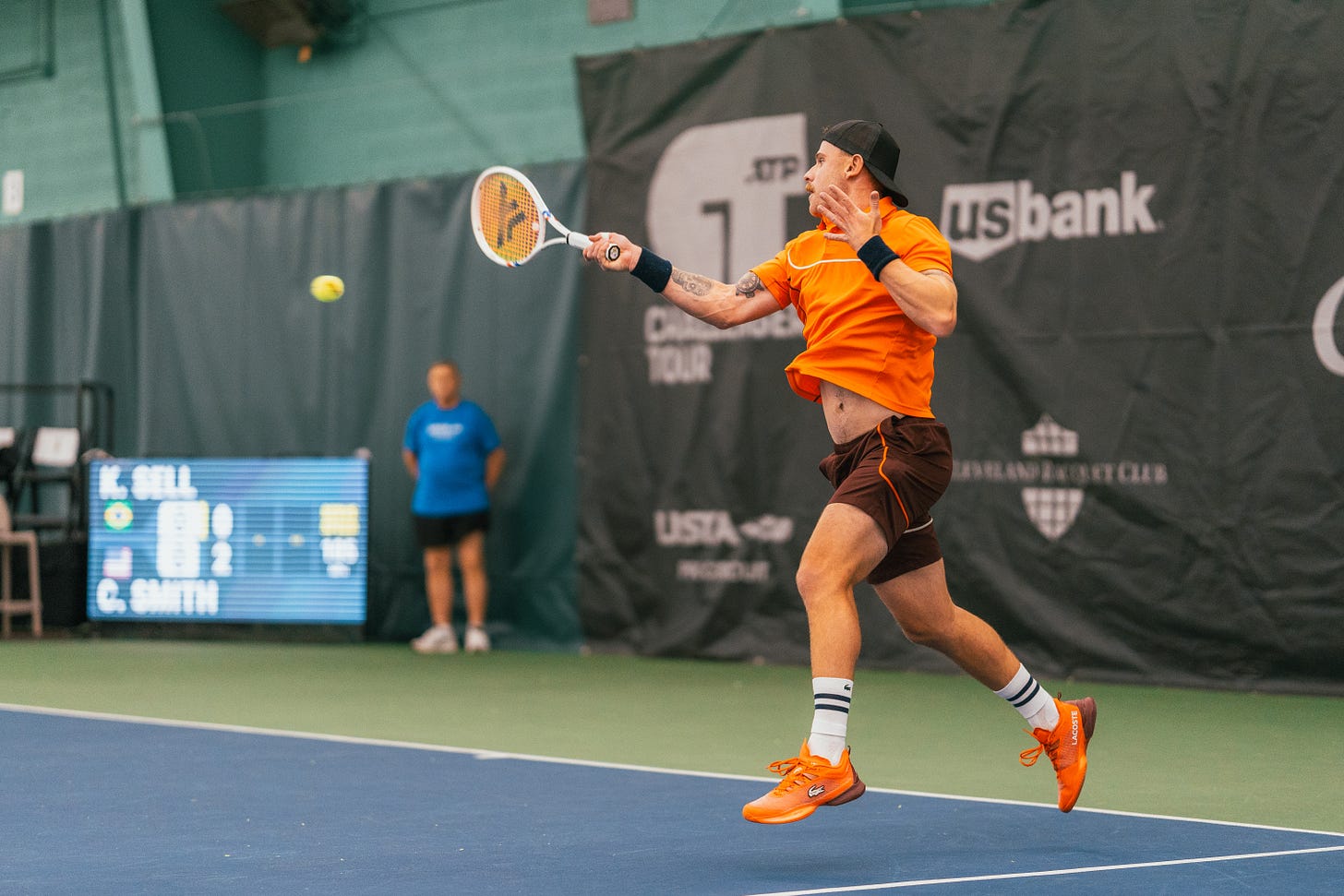Karue Sell returned to tennis powered by YouTube, proving that: "The sport has outgrown the Top 100."
Karue Sell might be more famous as a YouTuber than a professional tennis player but documenting his return to the sport opened a new career for him on and off the court.
Welcome back! Always glad to see you all back :) In this new edition, I’m bringing you an interview with professional tennis player and also YouTuber Karue Sell (who was in Naomi Osaka’s team at the US Open 2020), who has found a way to gather a strong audience and finance his return to the game, at 30, at the same time. Here is someone who understands the power of storytelling in tennis! Also scroll to listen to Coco Gauff, Marin Cilic and Mirra Andreeva, directly from Madrid.
This publication is supported by readers so if you like what you’re reading, don’t hesitate to spread the word, try a paid subscription, like this post or leave a comment as it helps TSS discoverability. You can also prefer to buy me a cuppa!
INTERVIEW
Karue Sell doesn’t want to be “seen as the guy who uses tennis to be famous”
Brazilian player Karue Sell, who lives in California and was Naomi Osaka’s hitting partner at the second US Open (2020) that she won, had been retired from the game for five years when he decided not only to come back in 2023 but to document it all on YouTube. Like Jules Marie in France, Sell found an eager audience (166k) not for his success but for his journey. He represents a new kind of content creator in tennis, who makes a very good business at showing what it’s really like to be a professional tennis player at a time when the game still struggles to find its storytelling A game (I mean, if you’ve been reading that space, you know…).
The path he carved out online actually financed his life on Tour, compensating for the fact that players who spend more time on the Challengers than the ATP or in the Grand Slam draws still struggle to live from their sport and so to get to the next level. Here we discuss how he’s working two jobs in one, with the opportunities (that are still less than what tennis currently help the WAGs make) and pressures that come with it. He also shares how he thinks tennis could package the players outside of the Top 100 better as the depth has never been that high in the Top 300.
You’re currently injured and had to give up on your hopes of playing Roland-Garros. Awful timing for the player and anwful timing for the content creator… How is it going?
Sell: It's an unfortunate timing, it was a bit annoying. It's the middle of the season, I was trying to get in some more matches and gear up for hopefully making some Slams, but it's the life right now. I think by May, I should be able to start hitting, maybe not moving so much. It could have been worse, so I'm just taking it all in and making the best out of it, I guess.
So turning pro at 30, I just love the concept. I love the boldness of it. It seemed to go well for you without being on the Tour, so what brought you back?
Sell: It was very random, to be honest. There was never a plan to play professionally again. Then, in 2023, the channel was growing, but financially, it took a long time. And in 2023, I was traveling as a coach, splitting the weeks because it's a lot of time on the road. I went to Australia, and when I came back, there was a UTR event here in Newport Beach: I played it and ended up winning. And then I went on another trip, came back, there was another UTR event and I ended up winning it.
So I started playing a few more tournaments just for fun and I started enjoying it again. I was just like, let's see if I can go get a point just for content. It was purely like, can I go out there and get an ATP point? Everyone kind of knew me at that point as a kind of coach and whatnot. They knew I was a good player, but, I was like, let's go try to get a point. I ended up going to Tunisia to play because I couldn't get into tournaments here in the U.S. I got a point, and that was just kind of fun; I made a video about it. And then my next event, at the end of 2023, I ended up winning it. I went to a 15K and I won the event. And at that point, you go from no ranking to 800 in the world, 700 or whatever. And, and then I was like, ‘Man, maybe I'll do this, you know, maybe’.
“The name “turning pro at 30” popped into my head. I think I nailed the name to be honest!’ (He laughs)
And now I’m thinking: I have the channel, obviously, and we’re seeing someone like the French player Jules Marie doing this comeback. So I felt there was something for me there. And in December that year, 2023, I needed to train again and do fitness, so I went all out. Then the name “turning pro at 30” popped into my head, as you need a name for the series and the content. I think I nailed the name to be honest (he laughs). I had just turned 30 in 2023, so it just worked out.
And now you hit your best single ranking (#258 in November 2024). Was it easy to come back as a professional player first and not a content creator or aren't you seeing things like that at all? Where's the line, especially when you're playing?
Sell: Maybe I come off as a very relaxed, chill guy. But if I'm in a tournament, we're there to win, we're there to play and win. And sometimes the content is going to get in the way. I need to be able to relax a little bit more and just play and film. Also you know how tennis players are: Everyone is a little guarded, so I don't want to be the one filming everything. You want to be respectful of everyone else. But for the most part, players have been really supportive, so I just slowly but surely started to film a match and then they'd be like, “Hey, can you send me the matches?” Many players don't get footage of themselves playing, yet you want to be able to watch yourself play.
“All I really want from the channel is to have access and play with some players, and maybe humanize them a little bit.”
I had a very hot start. I won a 15K. Then I won my first 25K of the year in 2024. I literally won the first tournament of the year, so I started really hot and just rode that confidence. I was able to beat my career high. I knew getting to 400 was going to be pretty achievable, but the fact that I blew past that, got into the Challengers and was close to making it to Australia was, I wouldn't say surprising, but for my first year I wasn't really expecting it.
There's one video, the one where you go to Belgium with Technifibre to customize a racket and you say, I bring value to the sport in an area it was lacking. Can you expand on that?
Sell: It's a very tricky thing, right? As a content creator and player, you want to share a lot of the story, a lot of the things. I look at a lot of golf and the content creation there is on a completely different level. The PGA Tour is working with golfers. Like they've gotten so big that I recently saw a YouTuber get a wild card for a PGA tournament. That's like pretty crazy, right? And so when you look at tennis, we're nowhere near there, you know, right? When I came into the space, there were some old-school guys who had been doing it for a long time, and then there was a new crop of people doing it, like Jules. There was a new group of people starting this tennis content thing.
I look at some of the golf channels like “I can be that guy.” I have a good amount of expertise in the field, I try to be as honest as I can with the process and the behind the scenes things. All I really want from the channel is to have access and play with some players, and maybe humanize them a little bit. Tennis players are so closed off. I try to be as honest as I can, that's sort of my goal. I hope that maybe, eventually, when I'm not playing professionally, I can still be at a high level and play with players, bringing them into the channel. Some of the videos I made where I was I played Taylor Fritz in a crappy practice set that I ended up still winning and people were losing their minds. So I hope I can stay in the space, helping tennis in a way.
The ATP, I think, is now going more into content creators. You're also seeing some players have their own like little videography teams. You can tell they're now seeing the value, whereas when I started, it was like, “What is this guy doing? What does he want?” But now it's like all these former players have their podcasts.
I like it when you say 'humanizing,' because the main coverage is so often about the top players, but these are the players who won’t open the doors. And when I read the comments under your video, it's a lot of people who feel it's relatable and they can really get into into the sport. Do you think it's also what you're bringing? Showing a more or less normal life of someone trying to make it on Tour?
Sell: At the end of the day, we can never compete with the Top 10 in terms of that, because they're the ones bring the revenue and bring the eyeballs. And it's just the way tennis is, the nature of the sport. But you go below, not even at my ranking, you go to the guy who's 40, 50, 60 in the world - like, I'd pay a lot of money to be in that situation - and traditional media will call them journeymen.
And it's such a disturbance to all of us, because I quit for five years and to me, now that I got back, I think the depth of tennis has gone crazy. Anyone from 350 and above is really good; they're complete players and extremely professional. And it's a hard funnel to get through. It's just the way it is. But if we could package it in a better way to show that the Tour has improved, like you can be a Challengers player and actually survive financially nowadays. It's not great, but it's not awful. But the general public is so unaware that a guy ranked 75 isn't necessarily that much better than a guy ranked 150. They just don't know, and they think there's this crazy disparity, so I just want to be able to show them. Last year, I was able to get Learner Tien on the channel, who went to the top 100 and beat Daniil Medvedev in Australia.
Do you think it's also a question of breaking the Top 100 storytelling? Like, introducing the Top 100 as the first goal. Maybe if we open the talk to the Top 300, it can bring also more money because then you're telling the brands, look, it's a viable product. I mean, that's what you're doing actually.
Sell: A hundred percent. I think to me, to me, the sport has outgrown the top hundred. Like there's too many players. Think about any sport nowadays, there's so much more talent. Like look at the NBA. Every single team has a couple of guys who are really good because everyone is training better and knows they have to improve to make it in the sport.
So, I think tennis is a very simple thing to me: the Grand Slams could solve the entire problem if they paid, let's say, $100,000 for the first round of qualifying. They have the money, right? So they can pay $100,000 first round of qualies. They don't have to go up like crazy. That will help guys ranked around 250 to make it through the year. The Slams could fix it all. I think 250 is the number. Let's sell the 250 really well and open up some more opportunities, maybe for those guys to play, not just Slams, but Masters and ATPs. If they’d start repackaging the story, it would be better. Now people are like, if you're 98, you're great, but if you're 110 you're terrible. You're so bad. It's very difficult to make people care about the guy ranked 90, but the entity should be able to sell the whole thing a little bit better.
That’s also when you go down the ranking that you can find more stories and more personalities, because again, the top players don’t want to open up. Also, many of them shot to the top pretty quickly and don’t have the same stories to tell.
Sell: It's so boring. What I do think, and what the general public also needs to understand, is that all these people playing professional tennis, they're just people. Think about when you went to high school, all the different characters that were there. You have someone who was very loud and brash. You have someone who's introverted. There are kinds of personalities. And they just happen to be great tennis players. So they're so singularly focused, a lot of them might not even like what they're doing. They have pressure from other people, whatever.
Unfortunately, it's very difficult. Even guys in the top 10, if they don't have the charisma sometimes, they just don't click with the audience. So it's just a hard sport to pick because, in a team sport, you're more affiliated with the team than with the player. And so it doesn't matter if they're winning or losing. But when you're supporting someone in an individual sport, you're always going to pick the guy who wins. So, how do you create a little better affiliation between a player and a fan? It's very hard. I've been able to do that because I give them my time online. I give them a lot of my time and a lot of my life, so they're supporting me. But it's a lot of work. And most tennis players just don't have the time to do it. And if they're going to hire someone to do it, then all of a sudden you're spending a lot of money on that. And you lose authenticity.
I don't know if you watched what Jannik Sinner did on YouTube after winning the Australian Open. The idea was great, yet the result felt flat…
Sell: That's the thing. And I think a lot of these media companies and the people that go in to help out with that, that's what they maybe don't understand or they're not able to get it. I'm doing it mostly on my own. I have an editor, but I'm the one who does most of the editing. I'm the one that is living the week, right? So people want to see how I did that week, not just cool shots of me hitting whatever. That's just not the point. It's not the point. That's what happens when big athletes start doing that because whoever is doing it, they're just following trends and trying to think of what will be watched the most, which is fair, but it's not really authentic. It is a hard thing to do.
Do you feel any added pressure? Tennis players need to win matches to earn money, right? You need to win matches to earn money, but you also need to create good content to earn money. Because your content is financing your tennis career, it's like a vicious or virtuous circle, depending on the circumstances. How is it mentally, emotionally to deal with that?
Sell: I feel more pressure to make the content on the matches, to be honest. I don't necessarily feel a lot of pressure from, “Oh, I have a big following on my journey!” This year, for example, I'm not having a great year, but I've always told myself that whether I'm doing well or doing bad, it's part of the story. I fortunately had a very successful 2024, so there was a lot of good stories, but now I'm having to deal with a more negative part of the whole thing.
“Nowadays, what pays my bills really is the channel”
But I do feel the pressure sometimes because you want to make good content, and it's a hard thing to be a bit constrained by an algorithm. So that can get in your head a little bit. There are also weeks when I'm tired and not mentally ready to create content and play matches. So, if I'm in a tournament, I need to walk in, play the matches, and hopefully the story will write itself, because that's the trickiest part for me. Nowadays, what pays my bills really is the channel, right? Mostly I have ad integrations in the video, and I work with brands that I use so to me, pushing them is great. That allows me to create content without putting anything behind a paywall to survive. I want to make free content that people can watch. So I need to be able to post those ads. But what happens is I have more deadlines now. So if I'm playing a tournament, I'm like, “Oh, I have three ads that I need to make this month.” So I need to actually make content to fulfill those contracts. That can get a little tricky, especially if I'm on the road for a long time. But I've found a good balance, and I now have an editor who helps with a lot of the stuff.
In tennis, we know the highs can be very high and the lows very low. We also know social media can be a rough place. Yet it seems you have a great community, so I’m wondering if it helped you deal with the rough tennis patches. Is your experience different than what other tennis players can experience online in terms of abuse for example?
Sell: I still have the same experience as players when they lose, that we get all the betters to come comment on our stuff, so that doesn't change at all. But to me, it's a really difficult thing, because, obviously, you make content - that's your life. But I struggle with just being chronically online. I want to live my life outside of online stuff. But I have a very supportive community for sure, and for the most part it's been like that. It hasn't been a lot of trolls or anything like that, but you obviously still get some of that stuff.
“I struggle with just being chronically online”
I think the interesting part is that now I'm in a position where other people might use my game or story to create their own content and have their own takes. Like, will he make it? Will he not make it? What does he need to do to become 100? So you get people who are going to piggyback on what you're doing, which is fair. It's a position I put myself in and I'm not worried about it. It serves their own purpose, but it's out of my control. That's the part I find funny. In the end, I just want to share my experience so that people are entertained by it. And hopefully that keeps the channel engaged.
You’re getting many brand deals, but I was surprised when you said that tennis brands didn't seem to want to collaborate with you. Even more when we see the money they’re now throwing into the WAG’s trend… You must be confused by that, no?
Sell: Yes, I am. I've had a very hard time with them. The tricky part with tennis brands is that they barely pay their top hundred players. They'll pay good money to the top guys; they don't pay those in the top hundred. So to then to them and say we got to pay this guy who is like 270 in the world, they’ll like, why? Well, get has a big YouTube channel and they're going to be like, well, it doesn't matter. But finally I was able to work with Tecnifibre, and hopefully it’ll be more than a content partnership and hopefully we can use their roster and get some people in, within the channel. So then brands can start seeing. But right now they just don't see it.
“I definitely make three or four times that just making content.”
Lacoste gives me free clothes, but we don't have anything in ink. And I do think that, you know, it's, it's a bit unfortunate that like maybe they don't see it yet, but hopefully, you know, hopefully I can slowly, but surely show them that like there’s value here. I'm not asking for a lot of money. If anything, I'm asking more for access. But I also guarantee I'd sell more rackets than some Top 100 players. So their money is going to be well spent as long as they help me as well. I could practice with Daniil or Iga. We could be doing fun content with their roster. That’s the goal. I’ll be at the French Open for example.
We all know that it’s very tough to make a living on Challengers, so if you had to put a ration comparing what you make by playing compared to what you make through content creation…
Sell: Last year, talking about what I took home, not with the expenses, I think I made like $40,000 playing. Obviously you spend all that money. That money is gone. And I definitely make three or four times that just making content. Today, content is my livelihood. It's a lot of revenue from different places, and I didn't make any money until we had around 100,000 subscribers. For everyone who's starting now, you have to realize that for years you're going to work for very little and you have to see maybe the end line. Now I can survive off the channel, but it's also a tricky thing because you never know with any algorithm change, and also because the economy is bad. A lot of that can happen, but it's my livelihood, so I have to create the content. It's just the way it is. You have to put content out to pay those bills to go on Tour, otherwise you can't do it. Also, I'm now married, I have two dogs, and I live in California, which is not cheap, so life has gotten significantly more expensive over the last five years too. You have to keep that up.
What are your goals now for the rest of 2025, on and off the court?
Sell: Well, as a tennis player, I mean, I have a very simple Top 200 goal, also win on the Challengers and play the Slams. I don't know if I can make it to the Top 100. I’d love to, but the reality is that I just want to play at the Top 200 level, because if I can do that, I play every Grand Slam. At the end of 2025, will I continue? I don't know, because it's not just about me now. At some point, I have to stop being the selfish tennis player. We're very selfish. But you have to, it's just the way it goes. And that's really my tennis goal, but I'm also trying not to overthink it anymore. I think I put a lot of pressure on myself to make it to the French Open because I had a clear path, and then I got unlucky here. So I'm going to go back to trying to relax, play the matches, and just enjoy it because I don't know how many years I have left to do this.
And content-wise, hopefully finish the year at 200,000 and continue to grow from there. Ideally have some of these experiences with some of the top players from the Tecnifibre roster. And maybe work with the ATP that I've been speaking to. They reached out recently.
Is it annoying to you if they say, oh, is a YouTuber playing tennis because you've been you've been a tennis player your whole life before you were a YouTuber?
Sell: It can be a little annoying, but I just take it now. I was in Sarasota, actually. And right before the match, there was a lady covering the tournament, taking photos, and creating a story, and I'm walking to the court, she looks at me and is like, “Are you the YouTuber?” I guess, but I'm also playing! I don't really care about that because you can’t control that.
The main thing I'd like is that my peers don’t want to play against me because, yes, I’m a YouTuber, but it’s going to be tough. Hopefully, I have already, but if I can earn their respect in that sense, and I'm not just seen as the guy who uses tennis to be famous. I've been doing this for twenty five years.
ATP/WTA MADRID: WHAT DID THEY HAVE TO SAY?
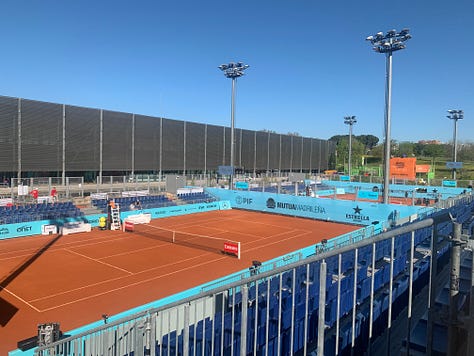
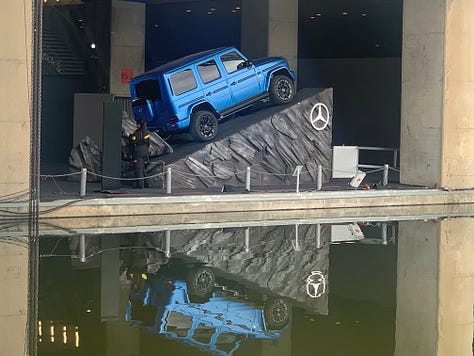
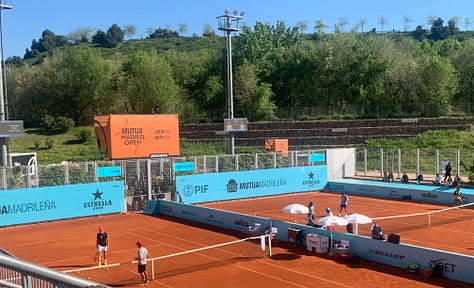
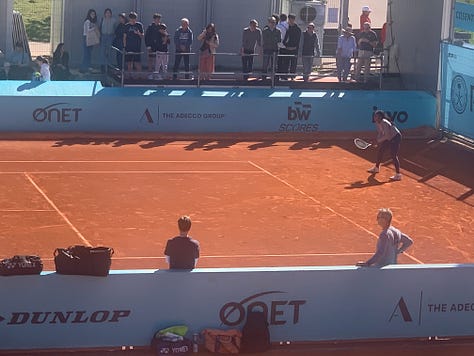
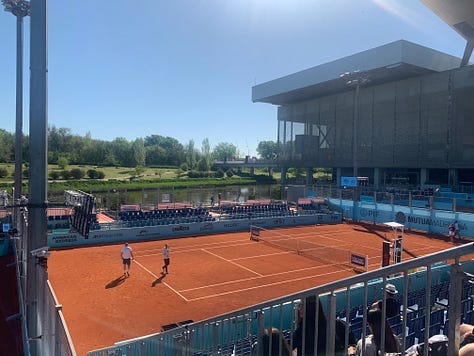
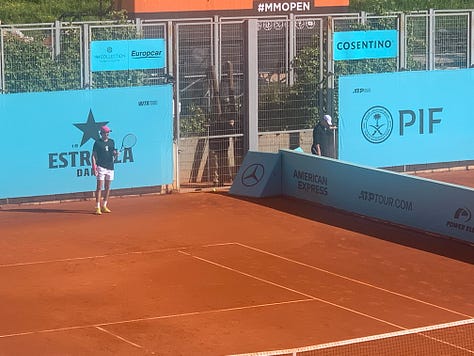
🎧 COCO GAUFF talks about finding her A-game back, female players’ safety, the prize money issue, and how women's tennis players still pave the way and need to keep doing it for the rest of women's sports.
🎧 MIRRA ANDREEVA, about dealing with high expectations, what skills she’d steal from which player and thanking herself at trophy ceremonies.
MARIN CILIC about going back to the Challengers Tour (2 finals, 1 title), being amazed at how the level has been raised there, and how he keeps building his return to the game.





